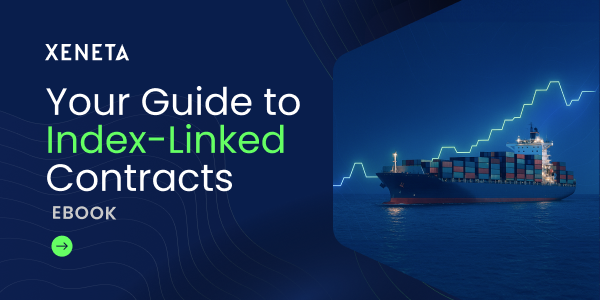Currently, consumers face an overall average effective tariff rate of 27%, the highest since 1903, and, despite the 90-day pause, trade tariffs still feel like a constantly moving picture with a huge amount of uncertainty around what could happen next.
The stakes are high, and the right actions are not always clear. Choosing the wrong response could be devastating, but failing to act could be just as costly.
“There seems to be more common acknowledgement that nobody expects this to be short lived, and the longer it drags on, the more inflationary the pressure will be.”
Patrik Berglund, CEO and Co-founder of Xeneta
In times like these, it’s crucial to combine data with community insights and freight experience to get a clearer understanding of the impact different strategies could have. And taking a look back at similar times can help create a clearer picture of what those impacts will be.
So how can we combine today’s data with past experiences to find the best route forward today?
Learning from the previous Trump administration
Since early April, shipping has been dominated by the need to navigate, adapt to, and weather the complex tariff landscape sparked by the Trump administration. But while extreme, this is not the first time we’ve experienced something like this. The Trump administration also rolled out tariffs on foreign imports, particularly from China, during its first term in 2018.
Many companies are frontloading to try and beat tariffs, especially now the 90-day pause is in effect. Frontloading also happened during 2018 causing the rates to spike followed by a rapid decline over the following six months. It’s important to note that while rates eventually declined again, they never fully return to the level prior to the spike.

This could happen again. However, this time the effect is likely to be less pronounced, as frontloading has already been happening in response to anticipated port strikes and Trump’s second term – meaning there's already a good amount of inventory in the US.
“Some of the decisions that have been made in the past have to be reconsidered under this new light of tariffs. Shippers are really thinking about which countries present the best set up to mitigate the risk. And this is very hard when there are frequent unclear and politically driven changes happening all around us."
Fabio Brocca, Chief Product Officer at Xeneta
Revisiting lessons from the Covid-19 pandemic
During the early months of the Covid-19 pandemic, demand was dampened by lockdowns and other response measures. And when demand decreases, carriers often take capacity out of the market with blank sailings. We’re seeing this again today, with shippers cancelling orders and exports from China and carriers enacting blank sailings to reduce capacity and potentially keep rates up.
How this situation differs to the pandemic is the fact countries have new LSP alliances in place and more trading options. This means carriers could decide to sacrifice rates in order to capture higher market share elsewhere.
How are shippers responding to the current wave of tariffs?
Short-term action tends to favor frontloading, spot usage, and re-routing, with companies also using scenario modelling and reassessing contracts to stabilize their long-term picture.
A lot of companies are holding off on taking rapid action; instead, waiting to see what happens next, monitoring what steps their peers are taking, or awaiting direction from business units on the course of action. Meanwhile, finance teams are carefully evaluating the cost implications of each potential initiative.
Other big volume players are taking more drastic measures, cancelling months of orders coming out of China and potentially causing rates to decline further.
These vastly different responses show just how complex the situation is. But there’s also a more middle-ground strategy that companies are adopting — using free zone warehouses where they can store cargo ready to extract and date stamp at a later time.

Some of the most popular actions currently being considered and planned by companies are:
- Exploring new trade routes (26%)
- Renegotiating contracts (24%)
- Moving volumes between suppliers (19%)
- Exploring index-linked contracts (12%)
- Shifting manufacturing set up (10%)
- Other (10%)
*Poll conducted by Xeneta, April 2025 (responses from Xeneta customers)
The best decisions are backed by comprehensive, real-time data
With such a complicated trade landscape and so many potential routes forward, it can be difficult to know which initiative is the right move for you. The best short- and long-term decisions are backed by robust intelligence into potential tariff, market, and trade route shifts. That’s why, at Xeneta, we help you navigate freight volatility with confidence, supporting you with the data you need to:
- Understand supplier strengths and weaknesses on trades you’re considering diversifying to or from
- Unlock port-level insight and understand differences in regional rates and service levels
- Monitor short- and long-term market movements as part of a wider freight procurement and diversification strategy
- Know the rates, transit times, and other key data points on alternative routes so you can be prepared to adapt your supply chain to market changes
Plus, you get access to the entire Xeneta Network, where you can connect with your peers to discuss ways to face challenging market and geopolitical conditions. This is particularly useful for cross-industry networking.
Our customers also get access to exclusive industry reports, early product releases and monthly webinars with our CEO and Co-founder, Patrik Berglund, alongside other experts and analysts from Xeneta. Here, you get insight into current market conditions, supported by specific examples and expert analysis into areas to watch. It’s a space where you can ask questions, give feedback, and interact directly with our team and your peers.
To learn more about everything we offer, schedule a demo today.
%201.png)






